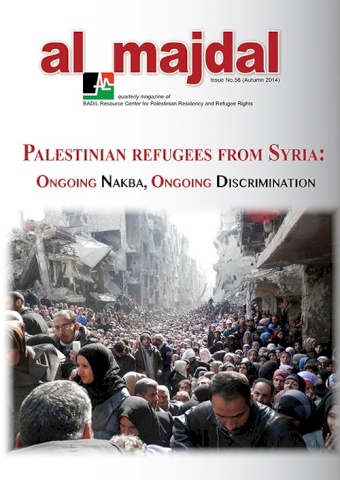Palestinian refugees from Syria: Ongoing Nakba, Ongoing Discrimination ( Issue No.56, Autumn 2014)

Editorial: Palestinian Refugees from Syria: Ongoing Nakba, Ongoing Discrimination
In this issue, Al-Majdal aims to present an account on the situation of Palestinian Refugees in and from Syria. We provide the most up-to-date data on Palestinian Refugees in/from Syria.
Of the 750,000 and 900,000 Palestinians who were displaced from Palestine during the Nakba, 90,000 found refuge in Syria in 1948.[1] By the start of the Syrian uprising in 2011, the Palestinian refugee population in the country had grown up to 500,000; they constituted almost 3% of the population of Syria and 10.5% of the Palestinian refugees falling under the mandate of the United Nations Relief and Works Agency for Palestine Refugees (UNRWA).[2] Over the last two years, an additional 40,000 Palestinian refugees have registered with UNRWA.[3]
Challenging the International Framework for Palestinian Refugees in light of the Syria Crisis
Introduction
In 2011, fighting broke out in Syria, creating over three million refugees fleeing mainly to surrounding Arab countries such as Lebanon and Jordan.[1] Alongside the Syrian citizens affected by the conflict is a population of about half a million Palestinian refugees.[2] As former Commissioner-General of United Nations Relief and Works Agency for Palestine Refugees (UNRWA), Filippo Grandi, put it in a January 2014 lecture at the American University of Beirut:
Palestinian Refugees from Syria in Lebanon: An Overview
The influx of Palestinian refugees into Lebanon started in July 2012, “after a string of mortar attacks upon the Yarmouk refugee camp killed 20 people”, and increased in December 2012, “when a Syrian jet bombed a mosque and a school inside the Yarmouk refugee Camp”.1
The Suffering of Palestinian Refugees from Syria in Lebanon: the Implications for the Right to Return
With Palestine remaining the central concern of the broader Arab nation, being at the center of the conflict between Zionism and the Arab countries, it follows that a constant and persistent monitoring of the changes sweeping through the Arab countries would be instructive to understanding how such changes might impact the Palestinian cause. One urgent and pressing matter within this broad theme is the plight of Palestinian refugees from Syria. While the world’s attention has understandably been focused on the repercussions of the Syrian crisis on the wider region, such as the way it impacts Israeli security and the possible impact on religious and ethnic communities across Syria, Iraq and Lebanon, this community has been largely neglected. This marks another chapter in the history of world apathy towards Palestinian refugees, whose suffering extends back to their original forced exile in 1948.
The Humanitarian and Legal Status of Displaced Palestinians from Syria and Lebanon
Palestinians have been displaced from Syria since the beginning of the conflict. However, since the doors were closed to emigration to other countries (legally and politically),[1] and due to the history of solidarity relationships with Syrians, the displacement of Palestinian refugees in Syria became an internal phenomenon. The refugee camps and relatively secure Palestinian communities were able to absorb those that were forced to flee.
Housing approximately a third of the Palestinians in Syria, Al-Yarmouk refugee camp is the largest camp in Syria. In December 2012 it was attacked by armed groups, forcing the regime’s forces to retreat and resort to military air strikes. Notwithstanding, the camp was able to absorb tens of thousands of displaced Palestinians, as well as some Syrians,[2] before the clashes led to its destruction, the death of hundreds, and the displacement of 95% of its inhabitants.[3]
Palestinian refugees from Syria in Jordan: An Overview
Palestinian refugees from Syria started fleeing to Jordan as early as March 2011, when the conflict reached the city of Dar’a, six kilometers from the Jordanian border.[1] The history of Jordanian-Palestinian relations seems to be behind the restrictive policies toward Palestinian refugees from Syria, officially announced by the Jordanian government in January 2013, but in practice since 2012.[2] What was called by Nikita Malik as the “Black September complex” – i.e., “[m]emories of the 1970 Black September civil war between the Jordanian government and Palestinian refugee militias” – “make Jordanian authorities wary of any political activities among the Syrian refugees”,[3] including Palestinian refugees from Syria. At the same time, the fear of being taken as the “alternative land” for Palestinians appears in official justifications of such policies: Jordanian authorities told Amnesty International in June 2013 that they do not wish to harm Palestinians’ ‘right of return’” and “that Israel should bear responsibility for the plight of Palestinian refugees”.[4]
Cyber City in Jordan: the Epitome of Palestine Refugees’ Despair and Legal Limbo
540,000 Palestinian refugees lived in Syria prior to the outbreak of the conflict in March 2011. For more than 40 years, Syrian governments claimed to be protectors of Palestinian refugees and guardians of their right of return to Palestine. However, in the course of the Syrian civil war, government forces did not refrain from shelling Palestinian refugee camps, resulting in extensive civilian casualties and destruction. According to UNRWA, more than 70% of the Palestine refugees in Syria are in need of emergency humanitarian assistance, and more than 50% are internally displaced.[1]

